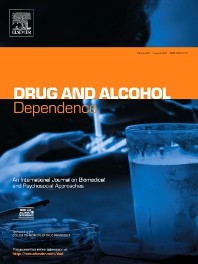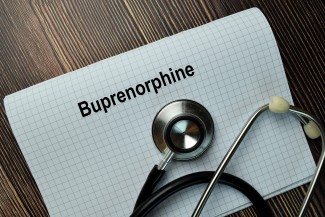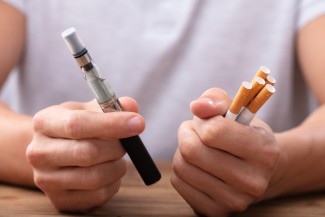Search
Harm reduction drug policy in Israel: what has been accomplished and what still needs to be done?
Scientific Evidence: Its Meaning and Contribution to the Drug Demand Reduction Field
Reprint of: Biotechnologies and the future of opioid addiction treatments
Biotechnological treatment, including addiction treatment, is the way of the future. Researchers and pharmaceutical companies praise depot injections, agonist/antagonist implants, deep brain stimulation, and hapten conjugate vaccines as...
Identifying content-based engagement patterns in a smoking cessation website and associations with user characteristics and cessation outcomes: a sequence and cluster analysis
Tobacco smoking is the greatest cause of sickness and early death worldwide, with 8 million people dying each year from a smoking-related condition. The use of pharmaceutical or behavioural assistance improves smokers' chances of quitting...
Evidence-Based Approaches to Opioid Overdose Recognition and Management: Share the Facts – Save Lives
The impact of COVID-19 on drug use and harm reduction programming in the Middle East and North Africa (MENA) region: a regional consultation of stakeholders and people who use drugs
COVID-19 (SARS-CoV-2) was classified a pandemic on March 11, 2020, with early reports of the disease occurring in the Middle East and North African (MENA) area. On January 2021, the World Health Organization Eastern Mediterranean Regional...
Changes in alcohol consumption patterns based on gender during COVID-19 confinement in Spain
Abstract
The goal of this study was to analyze the prevalence and pattern of alcohol consumption (frequency of consumption, average daily consumption, and risky consumption) before and during confinement due to the coronavirus disease...
Addressing long overdue social and structural determinants of the opioid overdose crisis: Drug and Alcohol Dependence Special Issue
This special issue addresses a rapidly growing area of research with a pressing public health need, the social structure of opioid use.
Specifically, this issue compiles original articles that apply theoretical and empirical frameworks to...
Urdu translation and adaptation of the HIV stigma scale in Pakistani injectable drug users with HIV
Abstract
Objective: To translate and adapt the human immunodeficiency virus stigma scale into Urdu language,
and to determine its psychometric properties.
Method: The study was conducted at the Human Immunodeficiency Virus / Acquired...
Gender disparities in opioid treatment progress in methadone versus counselling
The high dropout rate (75%) in opioid use disorder (OUD) treatment among women and racial/ethnic minorities in the United States necessitates a better knowledge of the factors that contribute to treatment success. While therapy and...
High-dose buprenorphine induction in the emergency department for treatment of opioid use disorder
In response to the rising efficacy of the illicit opioid drug supply and often observed delays in access to follow-up therapy, emergency departments (EDs) occasionally utilize a high-dose buprenorphine induction method for the treatment of...
Trends in use of e-cigarette device types and heated tobacco products from 2016 to 2020 in England
During the past decade, heated aerosolized nicotine delivery systems (HANDS) —mainly e-cigarettes—have surpassed nicotine replacement therapy as the most utilized aids for stopping smoking in England.
It is therefore important to explore...
Biochemical mechanisms associating alcohol use disorders with cancers
Abstract
The World Health Organization identifies alcohol as a cause of several neoplasias of the oropharynx cavity, esophagus, gastrointestinal tract, larynx, liver, or female breast. We review ethanol’s nonoxidative and oxidative...
Variation in brief treatment for substance use disorder: a qualitative investigation of four federally qualified health centres with SBIRT services
Brief treatment (BT) or regular outpatient alcohol use or substance use disorder (SUD) treatment is a key element of the Screening, Brief Intervention, and Referral to Treatment (SBIRT) model. It can be an effective, short-term, and low...
Global burden of cancer in 2020 attributable to alcohol consumption
Each year there are 3 million deaths as a result of the harmful use of alcohol.
As alcohol gets broken down, chemicals affect the way our body sends signals and communicates and increase the chances of developing cancer.
In this...
Marco conceptual y evaluación de una experiencia de prevención con base en actividades deportivas
ISSUP Argentina presentó un webinar sobre el marco conceptual y evaluación de una experiencia de prevención basada en actividades deportivas.
El webinar tendrá lugar el lunes 13 de septiembre de 2021 a las 6:00 p.m. (Hora de Argentina).
E...
Seminario Web:Intervenciones Comunitarias basadas en evidencia
ISSUP Argentina te invita a participar de un webinar sobre intervenciones comunitarias basadas en evidencia.
El webinar tendrá lugar el jueves 19 de agosto de 2021 a las 6:00 p.m. (Hora de Argentina).
19 de agosto de 2021, 18:00 - 19:00...
Is telemedicine the answer to rural expansion of medication treatment for opioid use disorder? Early experiences in the feasibility study phase of a National Drug Abuse Treatment Clinical Trials Network Trial
Abstract
Telemedicine (TM) enabled by digital health technologies to provide medical services has been considered a key solution to increasing health care access in rural communities. With the immediate need for remote care due to the...
Prevalencia y factores relacionados con el consumo de alcohol en adolescentes embarazadas: una revisión sistemática
Resumen
Introducción: el consumo de alcohol durante el embarazo (CADE) produce problemas físicos, cognitivos y de comportamiento en la madre y en el bebé en gestación, por ello se recomienda la abstinencia de esta sustancia durante el...
Share the Knowledge: ISSUP members can post in the Knowledge Share – Sign in or become a member





